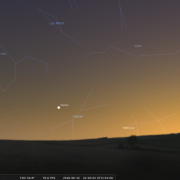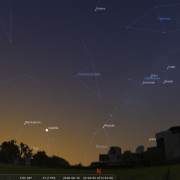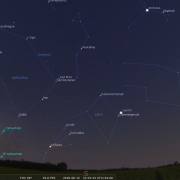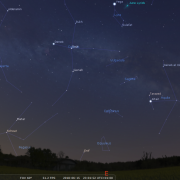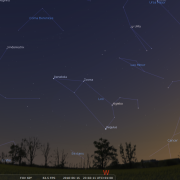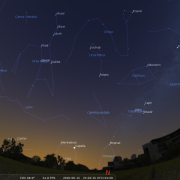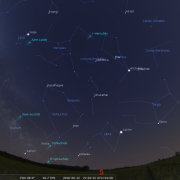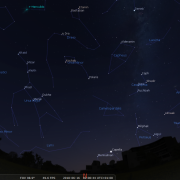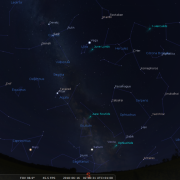In this month's Sky Notes:
Planetary Skylights
 At magnitude - 4.1 Venus continues to dominate the North-West twilight sky and is joined by a slim crescent moon in earthshine on the 16th. Over the course of June, Venus travels sideways more to the west from the WNW, not setting until after 23:00h. Telescopically (or indeed through any optical aid) Venus is dazzling, but if you view in bright twilight you will detect its phase, which is currently around half, nothing else will be seen.
At magnitude - 4.1 Venus continues to dominate the North-West twilight sky and is joined by a slim crescent moon in earthshine on the 16th. Over the course of June, Venus travels sideways more to the west from the WNW, not setting until after 23:00h. Telescopically (or indeed through any optical aid) Venus is dazzling, but if you view in bright twilight you will detect its phase, which is currently around half, nothing else will be seen.
 From mid June, Mercury arcs low into the North-West twilight sky slowly moving westwards until mid July. Look for a reasonably bright ‘star’ 45 minutes after sunset (22:15-22:30h) below and well to the right of Venus not far above the horizon. A flat, unobstructed view will be required, initially using binoculars to help pick out this elusive world. Once spotted you should be able spot it with the naked eye.
From mid June, Mercury arcs low into the North-West twilight sky slowly moving westwards until mid July. Look for a reasonably bright ‘star’ 45 minutes after sunset (22:15-22:30h) below and well to the right of Venus not far above the horizon. A flat, unobstructed view will be required, initially using binoculars to help pick out this elusive world. Once spotted you should be able spot it with the naked eye.

 Opposite Venus, Jupiter dominates the South-East sky and unlike Venus is a great telescopic target. Look for the Galilean moons (usually 2, 3 or 4 visible) strung out in line with Jupiter’s bands. Notable features and satellite events to look out for include – great red spot visible on the 2nd, 5th, 7th, 12th, 14th, 17th, 19th, 24th, 26th and 29th. Io shadow on disk visible on the 1st, 24th . Europa shadow transit on the 6th. There are unusual configurations of moons on 15 & 28th and finally Io disappears behind Jupiter at 22:30h on the 16th. All timings are for around 23:00h. Our Moon resides above Jupiter on the 23rd
Opposite Venus, Jupiter dominates the South-East sky and unlike Venus is a great telescopic target. Look for the Galilean moons (usually 2, 3 or 4 visible) strung out in line with Jupiter’s bands. Notable features and satellite events to look out for include – great red spot visible on the 2nd, 5th, 7th, 12th, 14th, 17th, 19th, 24th, 26th and 29th. Io shadow on disk visible on the 1st, 24th . Europa shadow transit on the 6th. There are unusual configurations of moons on 15 & 28th and finally Io disappears behind Jupiter at 22:30h on the 16th. All timings are for around 23:00h. Our Moon resides above Jupiter on the 23rd
 Saturn starts to appear in the late evening sky from the 20th onwards, and comes to opposition on the 27th, the same night the moon lies off to the left, it is also close by on the 1st. Look for a pearly ‘star’ low to the South-East from 22:30h onwards. The ring orientation is currently very favourable and any modest telescope should reveal them, but do be patient, waiting for those steady ‘seeing’ interludes in the often turbulent air in which Saturn resides. The tiny speck close by Saturn will be its chief moon Titan, which orbits round in 16 days.
Saturn starts to appear in the late evening sky from the 20th onwards, and comes to opposition on the 27th, the same night the moon lies off to the left, it is also close by on the 1st. Look for a pearly ‘star’ low to the South-East from 22:30h onwards. The ring orientation is currently very favourable and any modest telescope should reveal them, but do be patient, waiting for those steady ‘seeing’ interludes in the often turbulent air in which Saturn resides. The tiny speck close by Saturn will be its chief moon Titan, which orbits round in 16 days.
 Mars is now brightening quite rapidly, with the red planet technically becoming an evening object on the last day of June. Look for it well to the left of Saturn (post midnight for much of the month) low above the South-East horizon. Telescopically Mars appears smaller than you would expect as it nears opposition at the end of next month, but some surface detail will be discernable through more modest scopes, given steady seeing that is. The moon resides to the right on June 3rd and again on July 1st.
Mars is now brightening quite rapidly, with the red planet technically becoming an evening object on the last day of June. Look for it well to the left of Saturn (post midnight for much of the month) low above the South-East horizon. Telescopically Mars appears smaller than you would expect as it nears opposition at the end of next month, but some surface detail will be discernable through more modest scopes, given steady seeing that is. The moon resides to the right on June 3rd and again on July 1st.
Meteors

There are no major – or even semi major - meteor showers in June. There are a couple of minor showers; the Ophiuchids and June Lyrids. The former has two maxima, June 9th and June 20th, but peak rates barely reach sporadic levels (around 5 per hour). The same can be said about the June Lyrids which peak on the 15-16th. You will be extremely fortunate to spot any meteors belonging to these showers before midnight – which realistically leaves a couple of hours post midnight. Ophiuchus will occupy the area of sky low to the south, whilst Lyra is located high to south during the early morning hours. Moonlight will interfere somewhat for the June 20th peak.
The Summer Solstice
The Summer Solstice in the Northern hemisphere falls on June 21st, when the Sun reaches its greatest altitude in the sky on the ecliptic; the path it takes across the sky during a year. Within a couple of weeks the Sun start to retrace its steps southwards, as the axial tilt of Earth begins to shift away from it once again.
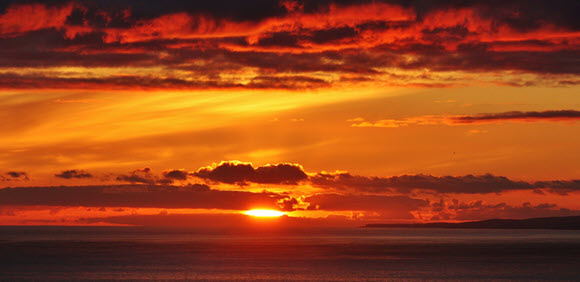
Summer Solstice. Image Credit: Ronnie Robertson
It is surprising how many people wrongly assume that Earth is closer to the Sun at this time of year; in fact the opposite is true. Earth is actually furthest from the Sun on July 4th at almost 95 million miles (153 million km), nearly 3 million miles more than when at its closest approach in early January. It is the inclination of the northern hemisphere towards the sun which causes days to ‘grow longer’ and feel warmer due to the higher concentration of sunlight per unit area. Think of this as being like a spot light directed onto to the palm of your hand, your palm feels hotter under direct radiation, whereas when the light is tilted, the angle reduces the heat intensity. The actual intensity of solar radiation in June is equivalent to approximately 1.2KW of heat for each square metre, although sometimes it feels as if someone’s forgotten to feed the meter.
Although known as the longest day, earliest sunrise and latest sunset times do not occur on the summer solstice date. Earliest sunrise falls around June 16th (from Whitby: 04:25h) whilst latest sunset occurs on June 25th (Whitby: 21:42h). It is the duration of useable daylight which reaches a maximum on the 21st, at just over 17 hours, with a meagre 4 hours of semi darkness.
Noctilucent Cloud
With bright twilight persisting well into the night, throughout June and into the July, watch out for the beautiful type of cloud formation seen only at this time of year known as noctilucent cloud. These delicate formations appear above the northern horizon, long after sunset, often around midnight. Shining quite brightly, noctilucent cloud is filamentary in structure, having a characteristic silvery-blue colour. It forms almost exclusively between latitudes 50 and 60 degrees north, high in the upper atmosphere: 50 miles up- five times higher than normal clouds.
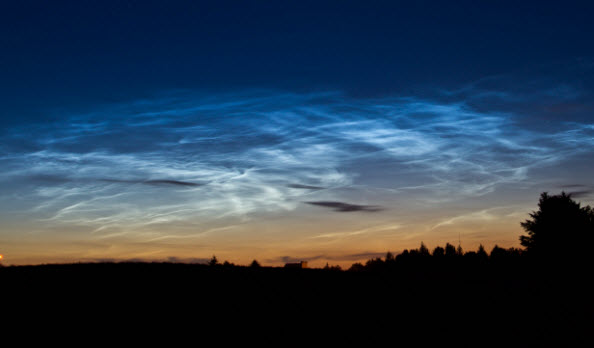
Noctilucent Cloud. Image Credit: NASA
It is thought that this type of cloud forms when water vapour condenses at the low temperatures that prevail at such altitudes onto particles suspended in the air. More frequent sightings of noctilucent cloud over the last half century may indicate that these particles could be a result of industrial pollution, perhaps from increased air traffic. Do keep watch!
|
Looking North
Mid-June - 23:00h |
Looking South |
|
Looking East
Mid-June - 23:00h |
Looking West
Mid-June - 23:00h |
|
Northern Aspect
Mid-June - 23:00h |
Southern Aspect
Mid-June - 23:00h |
|
Northern Aspect
Mid-June - 02:00h |
Southern Aspect
Mid-June - 02:00h |
Additional Image Credits:
- Planets and Comets where not otherwise mentioned: NASA
- Sky Charts: Stellarium Software
- Log in to post comments

